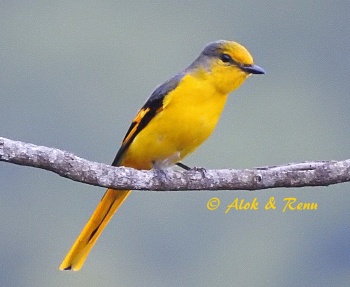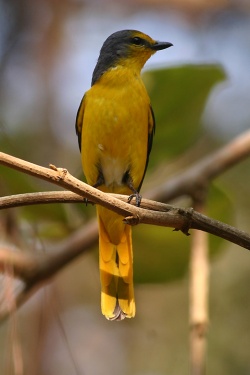- Pericrocotus speciosus
Identification

Photo by Alok Tewari
Sat Tal Forest, Alt. 5500 ft., Uttarakhand Himalayas, India, April 2017
17–22 cm (6¾-8¾ in)
- Black upperparts and head
- Scarlet underparts, tail edges, rump and wing patches
- Dark beak
- Long wings
Female: grey upperparts, yellow face, underparts, tail edges, rump and wing patches.
Distribution
Southern Asia from northern India east to southern China, Indonesia, and the Philippines.
Taxonomy
Orange Minivet was formerly included in this species. The scientific name Pericrocotus flammeus was used then for the enlarged species.
Subspecies

Photo by Alok Tewari
Sat Tal Forest, Alt. 5500 ft., Uttarakhand Himalayas, India, April-2018
There are 18 subspecies[1]:
- P. s. speciosus: Himalayas (Kashmir to eastern Assam); winters to northern India
- P. s. fohkiensis: South-eastern China (Hunan, Fujian, Guangdong and Guangxi)
- P. s. fraterculus: northeastern India (Assam south of the Brahmaputra River), northern Myanmar, southern China (Yunnan, Hainan), and northern Indochina
- P. s. semiruber: South-eastern India (eastern Ghats) to southern Myanmar, Thailand and northern Indochina
- P. s. flammifer: Southern Myanmar to south-western Thailand and northern Malay Peninsula
- P. s. xanthogaster: Southern Malaya, Sumatra, Bangka and Belitung islands
- P. s. andamanensis: Andaman Islands
- P. s. minythomelas: Simeulue Island (off Sumatra)
- P. s. modiglianii: Enggano Island (off Sumatra)
- P. s. insulanus: Borneo
- P. s. novus: Northern Philippines (Luzon and Negros)
- P. s. leytensis: Central Philippines (Samar and Leyte)
- P. s. gonzalesi: northern and eastern Mindanao (southern Philippines)
- P. s. nigroluteus: southern Mindanao (southern Philippines)
- P. s. johnstoniae: Mount Apo, Mindanao (southern Philippines)
- P. s. marchesae: Jolo Group (Sulu Archipelago)
- P. s. siebersi: Java and Bali
- P. s. exul: Lombok (Lesser Sundas)
Habitat
Evergreen and deciduous forests and other well-wooded habitats including hill country gardens.
Behaviour
Diet
They eat a wide variety of insects, including crickets, grasshoppers, caterpillars and cicadas.
Breeding
The cup-shaped nest is formed from woven twigs and spiders web. The clutch consists of 2-3 pale green eggs, which a mostly incubated by the female. Both adults care for the young.
Vocalisation
Recording by Alok Tewari
Sat Tal Forest, Alt. 5200 ft., Dist. Nainital, Uttarakhand Himalayas, India, April-2017
Call given by a feding party moving through the canopy. Calls by Bar-tailed Treecreeper and Himalyan Bulbul are also heard.
Recording by Alok Tewari
Sat Tal Forest, Alt. 5200 ft., Dist. Nainital, Uttarakhand Himalayas, India, April-2017
One female calling close to sunset time. It was minutes before sunset in the valley, this female was sitting on a dry branch and calling, just on the edge of the forest.
References
- Clements, J. F., T. S. Schulenberg, M. J. Iliff, S. M. Billerman, T. A. Fredericks, J. A. Gerbracht, D. Lepage, B. L. Sullivan, and C. L. Wood. 2021. The eBird/Clements checklist of Birds of the World: v2021. Downloaded from https://www.birds.cornell.edu/clementschecklist/download/
- Gill, F and D Donsker (Eds). 2010. IOC World Bird Names (version 2.7). Available at http://www.worldbirdnames.org/.
- Handbook of the Birds of the World Alive (retrieved January 2016)
Recommended Citation
- BirdForum Opus contributors. (2025) Scarlet Minivet. In: BirdForum, the forum for wild birds and birding. Retrieved 26 April 2025 from https://www.birdforum.net/opus/Scarlet_Minivet
External Links
GSearch checked for 2020 platform.1






